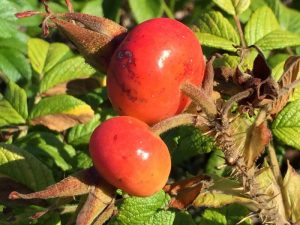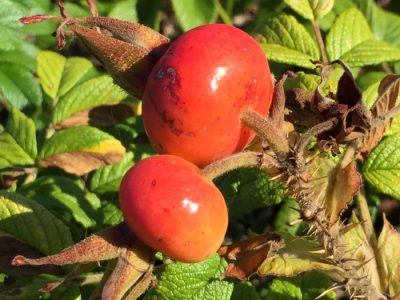 I’m visiting Cape Cod and just saw these lovely rose hips. They made me wish I was staying longer as I LOVE Rosehip Syrup.
I’m visiting Cape Cod and just saw these lovely rose hips. They made me wish I was staying longer as I LOVE Rosehip Syrup.
UPDATE: I PICKED SOME AND MADE SYRUP CLICK HERE
Rosehips look and sometimes taste like tiny apples. They are sweeter when there’s been a cold snap or frost, so early Fall is a good time to pick them.
Rosehips are hairy and full of seeds so they require special handling so you don’t get either stuck in your throat.
They are very high in Vitamin C and bioflavonoids and are anti-inflammatory says DIYNatural. All this strengthens the walls of our blood vessels, protects against infection, improves liver function, and lowers blood cholesterol and the risk of heart disease. Allegedly, rose hips also support a healthy placenta. And rosehip or petal tea has been used topically as a wash to improve capillary health in all parts of the eye for old-school treatments of cataracts and inflammation. (Find dried rosehips here.)
As well as making tea, I love the syrup, having been raised on a teaspoon a day as a kid to “fight colds.” This syrup can be used when a boost of immunity is needed, or when you want a delicious topping for ice cream or pancakes.
Rosehip Syrup Recipe
This Rosehip Syrup recipe from eatweeds.co.uk is packed with hedgerow goodness. Drink like a cordial or serve drizzled over ice-cream or add to milky deserts (or gin, just sayin’).
Rosehips contain twenty times more vitamin C than you find in oranges. As a result and due to the lack of citrus fruits, the British government during World War Two encouraged citizens to make rosehip syrup.
Ingredients
- 1kg rosehip: You can use either the small Dog rose (Rosa canina) or the larger Japanese rose (Rosa rugosa), both have excellent flavour.
- 3 litres of water
- 500g dark brown soft sugar
Suggested Instructions
- Bring to the boil 2 litres of water.
- Chop rosehips in food processor until mashed up, then add to boiling water.
- Bring water back to the boil, then remove from heat and allow to steep for 20 minutes.
- Pour rosehips and liquid into a scalded jelly bag and allow the juice to drip through. Gently squeeze the jelly bag to extract as much liquid as possible. Be careful not to rip the bag. (Kelly here: Back in the day, my mother used to strain rosehips through two or three layers of fine nylon stockings, tied to a towel rail, but I guess we’ve all moved on from that!)
- Add rosehip pulp back to a saucepan containing 1 litre of water and bring back to the boil. Then remove from heat and allow the contents to steep for another 20 minutes before straining through the jelly bag as in Step 3.
- Add sugar to the strained rosehip liquid and dissolve, allow to simmer for five minutes, then pour into hot, sterilised bottles.
Makes: Approximately 2 liters
